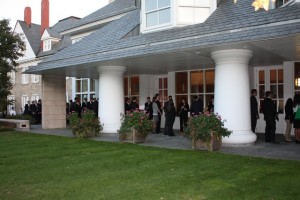Because of a National Science Foundation (NSF) fellowship last year, PhD candidate Whitney Coyle has worked to complete her doctorate in collaboration with a lab in Marseille, France. She recently received another fellowship from the French Embassy in Washington D.C. called the Chateaubriand Fellowship and the Graduate Research Opportunities Worldwide (GROW) program of the National Science Foundation fund.
Coyle completed her masters in acoustics at Penn State in 2012 and now spends 80 percent of her time in France working on her project titled, “Study of the acoustical properties of the clarinet in order to characterize the ease of playing.” She is one of sixteen NSF graduate research fellows who were selected among the best American doctoral students to participate in a three-to-twelve month research stay in France.
GROW helps students do research abroad by connecting them with premier educational and research institutions around the world. Coyle is one of five GROW laureates who are also part of the Chateaubriand Fellowship program.
Marketing and Communications Fellow for the College of Engineering, Kathy Andrusisin, talked to Coyle to learn more about researching in France.
Kathy Andrusisin (K.A.): What have you done as a Chateaubriand Fellow and with the NSF GROW funds?
Whitney Coyle (W.C.): After I received the NSF Graduate Research Fellowship last year I decided to choose a different topic for my PhD than I did for my masters. In order to get the most out of my fellowship (three years of funding) I decided to contact some researchers who already had lab space and materials as well as the background in clarinet acoustics that I lacked. When they agreed to work with me I knew that I would need to spend some time at their lab in France in order to accomplish as much during my time as an NSF fellow as I could, and luckily my Penn State adviser, Dr. Daniel Russell, was very supportive of this.
The main goal is to spend time in Marseille, France in order to use the measurement facilities and expertise of the researchers here, and I will also be able to work with researchers at the Institute for Research and Coordination in Acoustics and Music studying the clarinet and the clarinet manufacturers Buffet-Crampon in Paris.
K.A.: What research have you done for your project?
W.C.: My research concerns finding the acoustical characteristics of a clarinet that could help in defining an ideal instrument. This is more than just, does it ‘sound’ good? Is it playable by a professional? Right now the characteristic we are studying is the playing frequency of a clarinet and what affects it. We have numerical and analytical models, and we are beginning to take data from a number of different professional level clarinets owned by the French National Centre for Scientific Research lab in Marseille. I will be using these fellowships to remain in Marseille for eight months this year, but I will likely return the following year to continue data collection.
K.A.: How has receiving these fellowships helped your research?
W.C.: This year was the first year the NSF has offered the GROW fellowship for travel to France. The GROW fellowship offers funds to established NSF fellows in order to travel for up to a year in a foreign country. I also applied for the Chateaubriand Fellowship which is offered by the French Embassy in the United States. These funds were a little more flexible, allowing me to use these funds for lodging while in France as well. I was very surprised and ecstatic to receive both! Each of these fellowships is not only helpful in my everyday functioning during my time in France, but it also speaks very highly of Penn State and the graduate program in acoustics.
K.A.: What are you hoping to accomplish through your research in France?
W.C.: Spending time in France is somewhat twofold. I am getting to use the experimental set up here in Marseille. If not for that I wouldn’t get nearly as far in my research. Since musical acoustics research is little funded in the United States there isn’t too much happening at Penn State in this field. This means that I would have to begin from scratch making my own measurement apparatus. Being able to use already verified techniques and facilities here in Marseille will help propel my research forward.
K.A.: How will this research opportunity help you with your career goals?
W.C.: I am working with researchers at the top clarinet manufacturer in Paris, France, and this could be a possible career option for me in the future. I am networking with acousticians all over the world. These opportunities are so precious and few and I know that I would not be able to accomplish all of this had it not been for these funds.
K.A.: How has this opportunity helped you be a World-Class Engineer?
W.C.: Being in France has been a wonderful experience. Not only do I get to work in great facilities with well-known researchers in my field, I am learning French and really stepping outside of my usual comfort zone. I feel I am growing as a researcher, learning to ask questions and sharing my knowledge of not only science but culture as well. I am happy I am able to link the great researchers here in Marseille with those in my program at Penn State. I am sure we will find excellent results and hopefully produce more partnerships in the future.
Read More






Follow Us!